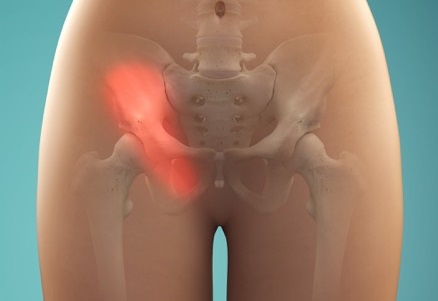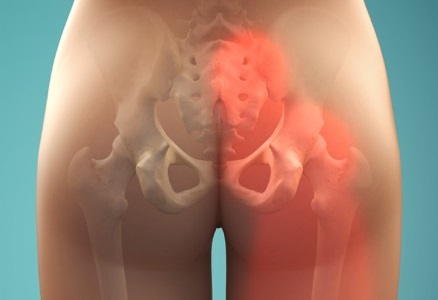SACROLIAC (SI) JOINT FUSION
About the Sacroiliac (S) Joint
The sacroiliac joints are strong joints (or articulations) between the bottom-most triangular bone of your spine, called the sacrum, and the ilium sections of the pelvis (the sections of the pelvis you put your hands on when you “put your hands on your hips”).
The Function of the Sacroiliac Joint
The function of the sacroiliac joint is both shock absorption (depending on the joint’s possible amount of movement) and torque conversion, to transfer movement in your lower body up to your spine.
Your sacroiliac joints act a lot like the suspension system in a car – they absorb your body’s daily dose of steps, jolts and bumps, and provide you with stability.
POTENTIAL SACROILIAC JOINT ISSUES
Why Sacroiliac (SI) Joint Dysfunction May Occur
Common Causes of Sacroiliac (SI) Joint Problems
- Injuries (a fall, car accident, or even a simple misstep)
- Pregnancy (the ligaments that allow the SI joint to stretch to allow for delivery may remain loose, post-pregnancy)
- Anatomic variation (such as uneven leg length or scoliosis)
- Prior lumbar surgery (fusion of the lumbar spine changes its natural movement and ability to absorb shock)
- Inflammatory joint disease (sacroiliitis)
The Difference Between Sacroiliac Joint Dysfunction and Inflammation
- Sacroiliac joint dysfunction refers to pain in the sacroiliac joint region due to abnormal movement in the sacroiliac joint – either too much movement, or too little. This abnormal joint movement typically results in inflammation of the sacroiliac joint.
- Sacroiliac joint inflammation, called sacroiliitis, describes inflammation in the sacroiliac joint. Sacroiliac joint inflammation may or may not be caused by sacroiliac joint dysfunction.
Why Sacroiliac Joint Dysfunction or Inflammation May Cause Pain
Common Symptoms of Sacroiliac Joint Dysfunction or Inflammation
- Pain in your low back, buttocks and/or legs
- Pain or discomfort performing common daily activities that require your pelvis to pivot, like getting in and out of bed, walking up or down stairs or even turning in a chair
- Difficulty sitting or lying down – especially if you experience an ache on one side of your body so painful it requires shifting your weight to the other side to gain relief
SACROILIAC JOINT DYSFUNCTION DIAGNOSIS
Diagnosing Sacroiliac Joint Dysfunction or Inflammation
The Challenge of Diagnosing Sacroiliac Joint Dysfunction and/or Inflammation
Connection between low back pain and sacroiliac (SI) joint dysfunction or inflammation


SACROILIAC JOINT DYSFUNCTION TREATMENT
Nonsurgical Treatment for Sacroiliac Joint Dysfunction and/or Inflammation
- Short-term rest – refraining from intense physical activity, twisting, turning or bending
- Medications – potentially including pain medicines, anti-inflammatory drugs, steroid injections, antibiotics, or radio wave nerve treatment
- Physical therapy – exercises to stretch and strengthen muscles of the lower back and/or the motion of the sacroiliac joint
- Preventive therapy – regular exercise, weight loss, and proper techniques for lifting
Surgical Treatment for Sacroiliac (SI) Joint Dysfunction and/or Inflammation
The SImmetry® Sacroiliac Joint Fusion System™
True Sacroiliac (SI) Joint Fusion
- Decortication – preparing the bone surface to trigger the body’s natural healing response
- Bone grafting – filling the space between bones with material bone may grow across
- Fixation – placing threaded implants that prevent the joint from moving during the healing process
Difference Between the SImmetry Sacroiliac Joint Fusion System and Other SI Joint Surgical Fusion Processes
- Minimal incision size
- Immediate post-operative stabilization
- True bone fusion, by creating the conditions that ensures bony growth across the SI joint
- Potential for a rapid recovery
TO LEARN MORE
Rx Only. Please consult a physician to review all indication, contraindications, warnings and precautions.
- Simopoulos TT et al. (2012) A systematic Evaluation of Prevalence and Diagnostic Accuracy of Sacroiliac Joint Interventions. Pain Physician; 15:E305-E344
- Cohen SP et al. (2013) Sacroiliac Joint Pain: A Comprehensive Review of Epidemiology, Diagnosis and Treatment. Expert Rev Neurother; 13(1):99-116
- DePalma MJ et al. (2011) Etiology of Chronic Low Back Pain in Patients Having Undergone Lumbar Fusion. Pain Medicine; 12:732-739
Contact Us - if you have more questions!
Inflammation, normal wear and tear, or even a single incident or accident can damage your SI joint, affecting their slight normal movement and creating chronic and often debilitating low back pain.
